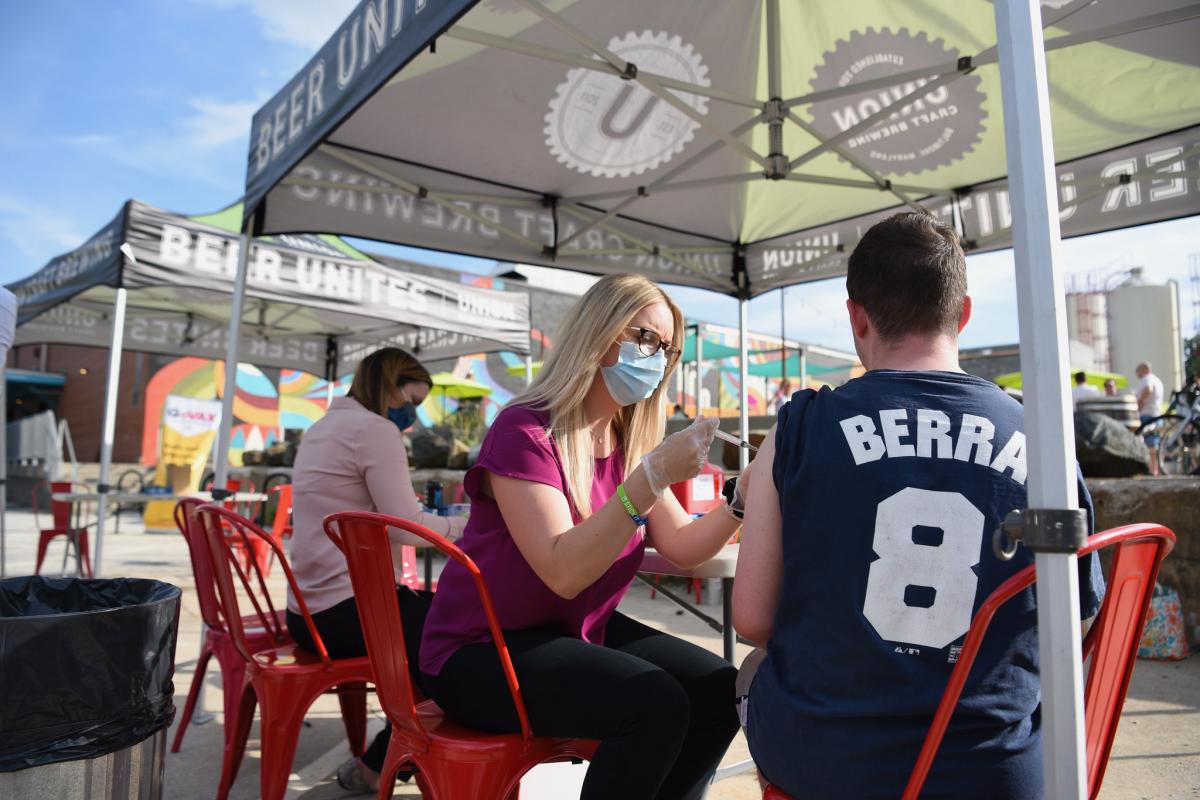
Just as many Baltimoreans are starting to feel as though life is getting back to normal, the coronavirus—now with its ultra-contagious Delta variant—is once again gaining an upper hand in the pandemic tug-of-war. So much so that last week, the U.S. Centers for Disease Control and Prevention updated its mask guidelines, recommending that everyone—including those who are fully vaccinated—mask up indoors in areas with “substantial or high transmission.”
Although Baltimore City and its surrounding counties are spared by the updated C.D.C mask guideline for now—with only a “moderate” level of community transmission—infectious disease experts and health officials are still urging residents to take measures in an effort to help the city fend off the worst outcomes from the potentially torrent Delta wave.
“We’re still well below the peak, but the trajectory is concerning,” says Dr. Aaron Milstone, an epidemiologist at Johns Hopkins Hospital. “The best way to bend the curve is to have people get vaccinated and put the masks back on.”
So far, Baltimore City has not reinstated its mask mandate (though other surrounding cities, such as Washington D.C., have.) However, City Health Commissioner Dr. Letitia Dzirasa says her department will “constantly be reassessing to determine if a change is needed in the future.”
Because the Delta variant appears to spread through respiratory aerosols and droplets, similar to prior variants—albeit much more aggressively—masks still remain an effective way to help curb the virus. To that end, Dzirasa encourages people to practice health mitigation measures—including masking, washing hands, and being cautious of going to large gatherings—regardless of whether there is a mandate to help slow the spread of the virus, especially to vulnerable populations such as children and the immunocompromised.
“I still wear a mask in public settings,” says Dzirasa, a mother of a four-year-old, “because I know my son is at risk.”
Despite the fact that Baltimore is currently experiencing lower infection rates than other places throughout the country, the Delta resurgence is already knocking on the city’s door. Currently, an average of roughly 28 city residents are reported to be infected with the coronavirus daily, which is almost five times the average caseload from four weeks ago. And the city’s seven-day average infection rate has dialed up to 1.6 percent, almost quadrupling the rate from the previous four weeks.
“The game has really changed,” says Dr. Gregory Schrank, an infectious disease specialist at University of Maryland Medical Center. “And that change came with the Delta variant.”
The fourth notable mutation of the original coronavirus that turned the world upside down, the Delta variant—which originated in India last December—has been referred to as “the coronavirus on steroids.” People who contract the strain may display the same symptoms as the virus’s original version, but current evidence supports that the variant could be more than twice as transmissible. Within the U.S., the variant is believed to be the culprit of more than 80 percent of new COVID-19 infections, the C.D.C estimates.
And the Delta variant is so contagious that even some vaccinated individuals have been reportedly infected. (These are what scientists call “breakthrough infections.”) However, Schrank points out that the relatively low numbers of breakthrough infections—out of millions of vaccinated individuals—are expected, since the COVID vaccines cannot be 100 percent effective at preventing infection, even with prior variants.
“Unvaccinated adults are still the driver of surges and high levels of community transmissions,” he emphasizes. “The vaccines remain highly effective at preventing the most severe cases of COVID-19, leading to hospitalizations and death.”
Despite the importance of COVID vaccines, Baltimore—following the national trend—has experienced a major slowdown in its overall vaccination rate in recent months. As of August 1, only 52.7 percent of Baltimore City residents over the age of 12 have received full vaccinations. “It’s not enough,” says Milstone, pointing out that the only way to end the pandemic is through vaccination.
Dzirasa agrees: “I think the call for action is to get as many folks vaccinated as possible,” she says, adding that the city’s long-term goal is to achieve at least an 80 percent vaccination rate. One of the efforts to meet that goal is the city’s partnership with area colleges, which has been targeting unvaccinated demographics in Baltimore neighborhoods.
It is unclear how long the infection rate will continue to climb in Baltimore. “That’s the crystal ball that no one has,” says Milstone, who explains that the possibility of a larger outbreak in the region is largely dependent on people’s behavior. “If people listen to public health measures, then hopefully rates will go down. If people don’t listen to public health measures, then, unfortunately, rates will continue to climb.”
Schrank, the University of Maryland infectious disease doctor, agrees. Currently, the hardest-hit areas of the Delta surge are among the parts of the country where vaccination rates and mask acceptance are relatively low. Therefore, by urging people to mask up and advising those who are unvaccinated to get the jabs, Schrank thinks Baltimore still has a window to fend off a particularly perilous Delta outbreak.
“We don’t want to bring ourselves to that point,” Schrank says, referring to the ongoing outbreaks in the country’s hit-hard regions. “Let’s just take the opportunity [to act] now.”
